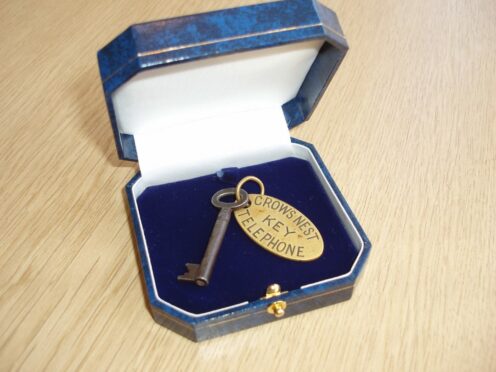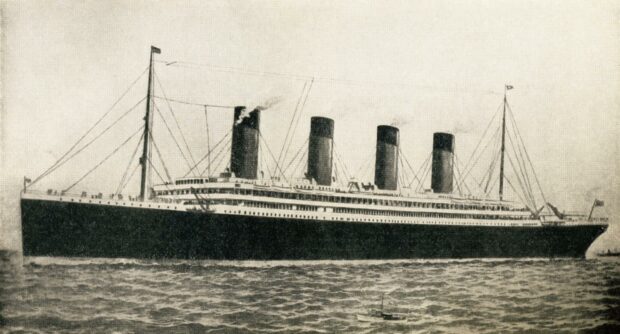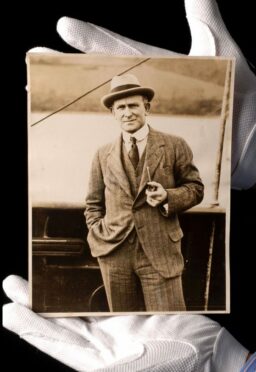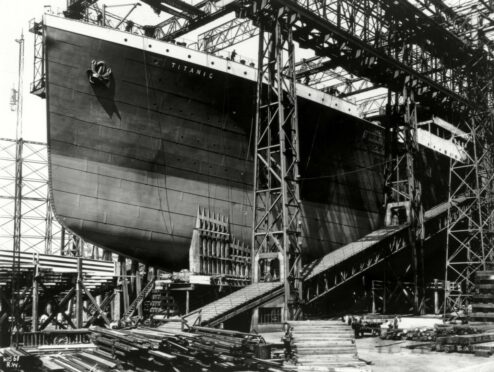Medals belonging to a Dundee sailor who almost certainly cheated death, but may have unwittingly helped sink the Titanic, could fetch up to £15,000 at auction.
White Star Line merchant seaman David “Davy” Blair was due to serve on the RMS Titanic’s maiden voyage across the Atlantic in April 1912.
But a change in crewing lists at the last minute saw the second officer from Broughty Ferry taken off the passenger liner.
In his hurry to disembark the ship at Southampton docks, Davy accidently took a locker key with him.
It was an innocent oversight, but one that likely contributed to the sinking of the Titanic.
The seemingly innocuous key was in fact the key to the cupboard in which the crow’s nest binoculars and telescope were kept locked away.
Titanic’s lookouts on that fateful night had no access to binoculars, and failed to spot the iceberg until it was too late.
Who was Davy Blair?
Davy Blair was born on November 11 1874 at Newport on the Isle of Wight, but was raised in Broughty Ferry.
The son of Lieutenant-Colonel John Blair and Clementina Blair, he pursued a career in the Merchant Navy, becoming a Second Mate in Dundee in 1896.
He was promoted to Master – the highest rank in the Merchant Navy – in Edinburgh in 1901.
An experienced seafarer, Davy was appointed First Second Officer on Titanic having been involved in its early sea trials in Belfast and a sailing on April 3 1912.
He was aboard for Titanic’s final voyage from Belfast to Southampton to test its seaworthiness.
But just days before the ocean liner was due to set sail for New York, White Star Line shuffled its officers between Titanic and her sister ship RMS Olympic, and Davy lost his posting.
It was a decision that saddened him.
He sent a postcard to his sister-in-law, writing: “Am afraid I shall have to step out to make room for chief officer of the Olympic.
“This is a magnificent ship, I feel very disappointed I am not to make her first voyage… I hope eventually to get back to this ship.”
But when he left Titanic on April 9, he would never set foot on it again.
The ship sank on April 15 after striking an iceberg, claiming more than 1,500 lives.
Did Davy’s error sink the Titanic?
Investigations into the sinking of the Titanic raised lots of questions, including the obvious – why had the iceberg not been seen sooner?
It was believed Davy inadvertently hampered the ability of Titanic’s lookouts during the transatlantic crossing.
The official inquiry heard from surviving crew members, lookouts Frederick Fleet and Reginald Lee.
The pair told the inquiry they would have spotted the iceberg sooner had they had the means to do so.
When questioned how much sooner, Fred replied: “Enough to get out of the way.”
Davy kept the key as a memento and it was considered to be one of the most important artefacts from the Titanic.
He died at the age of 80 in 1955 and the key was passed on to his daughter Nancy.
It later sold at auction for £90,000 in 2007 and the proceeds were used to set up scholarships in Davy’s name.

Recognition for bravery at sea
Now Davy’s medals for gallantry, earned during his seafaring career after the Titanic, are set to go under the hammer.
In 1913, when he was First Officer on the SS Majestic, he jumped 40-foot overboard to help save a crew member from the chilly waters of the Atlantic.
The ship was 700 miles from New York when a stoker from the engine room “rendered temporarily insane by the heat of the stokehold had rushed on deck, and in his frenzy thrown himself into the sea”.
Davy, who had just come off duty, heard the commotion and “without a moment’s hesitation” dived from “the dizzy elevation” to the man’s aid.
A report about the rescue in the London Gazette at the time said: “On the morning of 6th May, 1913, whilst the Majestic was in the North Atlantic, a Fireman jumped overboard.
“Vessel was backed to the place where he was supposed to have gone overboard and after some time he was sighted close to the port bow.
“Starboard emergency boat was lowered but Mr Blair, fearing that the boat might not reach him in time, jumped overboard from the port side of the vessel, swam to a lifebuoy which had been thrown overboard, and endeavoured to reach the man with it.
“He did not succeed, but, although weakened by the coldness of the sea, he managed to point out the whereabouts of the man to those in the boat, who rescued him and then picked up Mr Blair.
“There was a fog prevailing at the time and the water was very cold.”
The act of bravery saw him awarded the Sea Gallantry Medal from King George V at Buckingham Palace in 1915 and a medal from the Royal Humane Society.
A total of nine medals awarded to Davy will be going to auction as one lot on November 13, including his OBE, First World War service medals and his Legion d’Honneur – the highest French order of merit.
His Mercantile Marine identity card, service card, medal documentation and 13-page handwritten account of the 1913 sea rescue are also part of the same lot.
An opening bid of £6,000 has already been secured, but experts predict the collection could fetch up to £15,000 when it goes under the hammer in Wiltshire at Henry Aldridge & Son Ltd later this month.
If you enjoyed this, you might like:
















